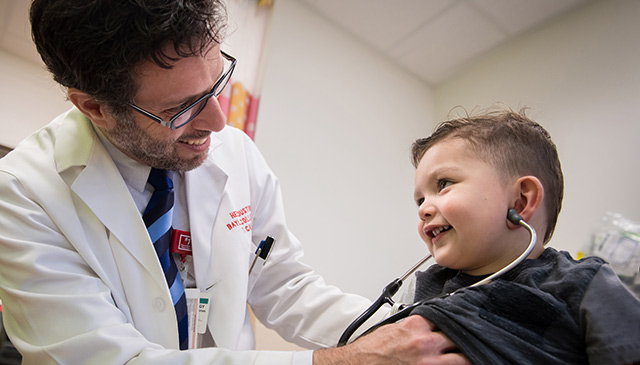
Texas Children’s Heart Center was once again the site of a groundbreaking novel treatment that gives experts in our new catheterization laboratories yet another method at their disposal in the treatment of complex heart conditions.
Dr. Henri Justino, co-director of the center’s cardiac catheterization labs and director of cardiac innovation, recently developed and performed a first-of-its-kind procedure in which a young patient’s lung veins were reached directly through the chest wall.
Hope for Bronx
Three-year-old Bronx Delarosa was born with total anomalous pulmonary venous return, a critical heart defect that causes oxygen-rich blood returning from the lungs to be pumped into the right atrium instead of the left atrium, as it normally should. There, the oxygen-rich blood mixes with oxygen-poor blood, which means the body doesn’t get the oxygen it needs.
At just 8 days old, Bronx underwent a surgery to repair the defect that was initially thought to be a success. However, following a second surgery, doctors told his parents he’d developed a secondary condition – pulmonary vein stenosis, a condition that caused severe narrowing in his surgically repaired veins. The Delarosas were heartbroken when they learned there was nothing else that could be done for Bronx in their hometown.
To give their son a fighting chance, they turned to Texas Children’s Hospital.
Breaking new ground
Justino performed Bronx’s first catheterization procedure in February 2018, during which he placed a metal stent in the blocked upper vein in Bronx’s right lung. However, he was unable to relieve the blockage in the lower vein.
After a personal friend underwent a lung biopsy, where a tissue sample was taken directly through the chest wall, Justino wondered if a similar approach could be applied in cases like Bronx’s – entering the veins of the lungs through the chest.
After thorough research, Justino decided to move forward with the unique approach to relieve the blockage in Bronx’s right lung.
Bronx was taken to the catheterization lab where the team performed a CT scan to identify the exact location where the blocked vein was sufficiently far apart from artery, yet close enough to the chest wall, to allow a needle to enter the vein directly between the ribs. Justino and his team also generated a 3-D computerized model to pinpoint the exact location where the needle would enter Bronx’s chest. To ensure the utmost accuracy, a laser crosshair was beamed on his chest at the entry point.
Justino carefully made his way into Bronx’s lung and placed a tiny catheter, the thickness of a raw spaghetti noodle. He then used a special wire to deliver radiofrequency energy to get across the blocked vein and into the heart. From there, the wire was threaded down through Bronx’s leg. This allowed a stent to be placed in the blocked vein via a catheter in the leg.
Bronx recovered well and a follow-up echocardiogram proved the experimental approach was a success. The first-of-its-kind procedure, which lasted more than eight hours, was performed in one of the Heart Center’s new state-of-the-art, 1,000-square-foot cardiac catheterization labs, which Justino helped design with this type of procedure in mind.
“We are proud that Dr. Justino was able to develop this completely novel procedure for Bronx,” said Texas Children’s Chief of Pediatric Cardiology Dr. Daniel Penny. “Pulmonary vein stenosis in children is an extremely difficult problem to treat and tests the limits of our abilities to innovate. We see this new procedure as another advancement in the treatment of these children, which will be applied more widely in the future and help us improve the care we offer for complex cardiac conditions.”
Learn more about Texas Children’s Heart Center, ranked No. 1 in the nation by U.S. News & World Report.

